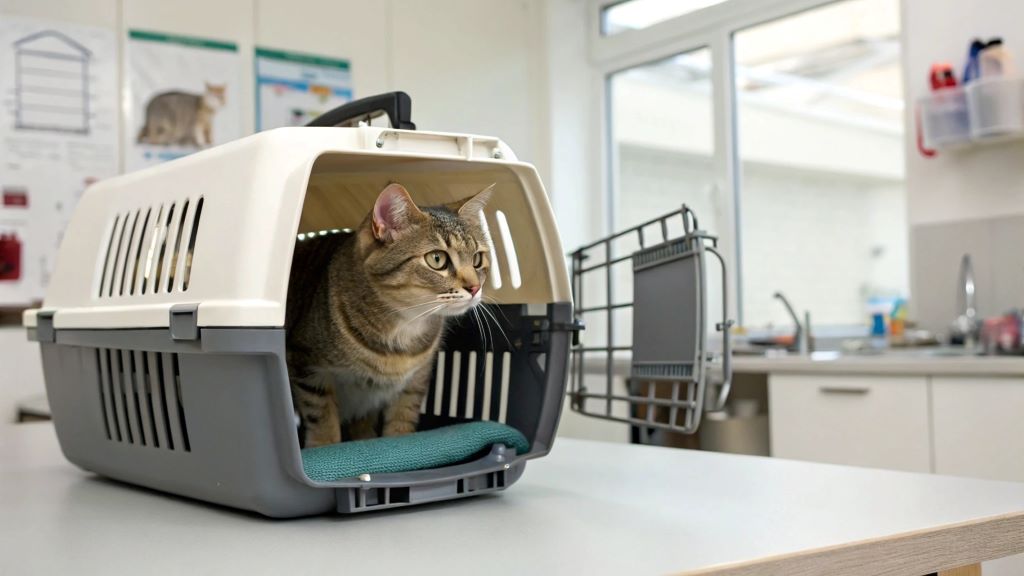How Often Do You Take a Cat to the Vet? What Every Cat Parent Should Know

For many pet parents, cats are more than just animals—they’re family. Whether you’re a new cat owner or a seasoned feline enthusiast, ensuring your cat receives the best health care is essential to a long, happy life. A significant part of that care involves regular visits to the veterinarian. But exactly how often do you take a cat to the vet?
Understanding your cat’s health needs at different stages of life will help you stay on top of preventive care, vaccinations, dental checkups, and any age-related concerns. Regular vet visits not only keep your cat healthy but can also detect potential issues before they become serious.
Additionally, pet care websites like Kooiii.com provide helpful resources for cat owners looking to educate themselves on proper feline health routines, nutrition, and lifestyle tips.
How Often Do You Take a Cat to the Vet?
You might be wondering, how often do you take a cat to the vet? The answer depends on several factors, including your cat’s age, overall health, lifestyle (indoor or outdoor), and breed-specific conditions. Generally, most cats should visit the vet at least once a year, but kittens, seniors, and cats with chronic conditions may require more frequent checkups.
Let’s break down the ideal veterinary schedule according to your cat’s life stage:
Veterinary Visits by Life Stage
-
Kittens (0–1 year)
Kittens require the most frequent vet visits to ensure proper development and to receive essential vaccinations.
- Initial visits start as early as 6–8 weeks of age.
- Vaccinations include feline distemper, feline herpesvirus, calicivirus, and rabies.
- Spaying or neutering is typically recommended between 4–6 months.
- Parasite control is also important, including deworming and flea prevention.
Recommended frequency: Every 3–4 weeks until 16 weeks old.
-
Adult Cats (1–7 years)
Once your cat reaches adulthood, the vet visit frequency can decrease, assuming your cat is healthy and up-to-date on vaccinations.
- Annual exams typically include a physical checkup, vaccinations, dental assessments, and weight monitoring.
- Preventive tests may involve blood work and fecal exams.
Recommended frequency: Once a year for healthy adult cats.
-
Senior Cats (7+ years)
Cats are considered seniors around the age of seven, and like humans, they become more prone to chronic health issues.
- Twice-yearly exams are recommended to catch early signs of arthritis, diabetes, kidney disease, and hyperthyroidism.
- Blood tests and urinalysis may be performed to monitor internal organ function.
- Weight tracking is crucial, as sudden weight loss or gain can indicate deeper health concerns.
Recommended frequency: Every 6 months.
Why Routine Vet Visits Matter

Routine vet visits are vital for:
- Early Detection of Disease: Cats are masters at hiding pain and discomfort. Regular checkups can detect illnesses like kidney disease or diabetes early.
- Vaccination Updates: Keeping your cat’s vaccinations current helps prevent diseases such as rabies and feline leukemia.
- Dental Health: Poor oral hygiene can lead to severe infections. Vets often check for gingivitis, tartar buildup, and other dental issues.
- Behavioral Changes: If your cat’s behavior shifts—such as excessive grooming or aggression—a vet can determine if a medical issue is behind it.
According to the American Association of Feline Practitioners (AAFP), even indoor cats benefit from regular veterinary visits, as they are still at risk of obesity, dental disease, and age-related illnesses.
Additional Considerations for Vet Visits
Indoor vs. Outdoor Cats
Outdoor cats are generally more exposed to parasites, injuries, and infections. They often require more frequent visits compared to indoor cats.
- Indoor cats: Annual checkups are usually sufficient.
- Outdoor cats: May benefit from biannual exams and more aggressive vaccination schedules.
Chronic Conditions and Special Needs
Cats diagnosed with chronic illnesses like hyperthyroidism, diabetes, or kidney disease will need closer monitoring. This might include:
- Blood work every 3–6 months
- Medication adjustments
- Nutritional changes
Emergency Visits
In addition to routine care, it’s crucial to recognize when your cat needs urgent attention. Symptoms like difficulty breathing, seizures, vomiting, or not eating for more than 24 hours require immediate veterinary care.
Tips for Stress-Free Vet Visits
Getting your cat to the vet can sometimes feel like a battle. Here are a few ways to ease the stress:
- Use a familiar carrier lined with soft bedding.
- Acclimate early: Leave the carrier out at home so your cat sees it as a safe space.
- Minimize car ride stress: Keep the ride smooth and quiet.
- Reward your cat after each visit with treats or cuddles.
Kooiii.com also shares helpful guides for minimizing pet anxiety and traveling with cats, offering support for new and experienced pet parents alike.
5 Popular FAQs About Taking Cats to the Vet
- Is it necessary to take my indoor cat to the vet every year?
Yes. Even if your cat doesn’t go outside, it can still develop internal issues like dental disease or obesity. Annual exams are essential. - How much does a routine vet visit cost?
Routine exams typically range from $50 to $150, depending on location and services. Additional tests or vaccinations may cost more. - What vaccines do adult cats need?
Core vaccines include rabies and FVRCP (feline viral rhinotracheitis, calicivirus, and panleukopenia). Your vet may also recommend feline leukemia for outdoor cats. - What signs indicate my cat should see the vet sooner than scheduled?
Watch for signs like lethargy, appetite loss, vomiting, diarrhea, coughing, or changes in urination. These may indicate underlying issues. - Do older cats really need vet visits every 6 months?
Yes. As cats age, they are more susceptible to chronic diseases. Biannual checkups can catch and manage problems early, improving their quality of life.
Conclusion
So, how often do you take a cat to the vet? While once a year is the minimum for healthy adult cats, kittens, seniors, and those with health issues require more frequent visits. Staying consistent with vet care can add years to your cat’s life and reduce emergency situations in the long run.
Preventive care is the cornerstone of feline wellness. With the support of professional guidance and informative platforms like Kooiii.com, cat parents can feel confident in giving their furry friends the care they deserve.
Make vet visits a regular part of your cat’s routine—it’s a small effort that can make a big difference.
Read More:







